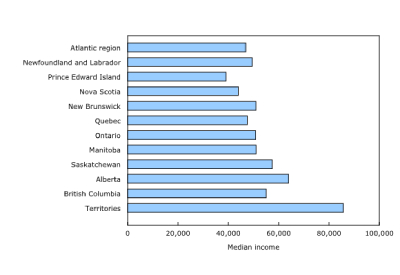Earnings and Mobility Indicators for Newly Certified Journeypersons in Canada, 2018

November 5, 2021
By Statistics Canada
The employment income of those who certify in the trades, otherwise known as journeypersons, varies markedly across Canada, with those plying their trade in the North and Western Canada making more on average in 2018 than those in Central and Eastern Canada. Despite this, starting employment incomes of newly certified journeypersons in the resource-rich provinces of Alberta, Saskatchewan, and Newfoundland and Labrador have fallen since 2014, while the income of journeypersons in Central Canada has risen. A new study sheds light on the labour market transitions of newly certified journeypersons using 2018 tax data, the most recent year for which these data are available.
The median employment income of the 54,475 journeypersons who obtained certificates in the trades in 2018 was $52,250. Newly certified journeypersons in Alberta ($63,920) and Saskatchewan ($57,500) earned the highest median employment incomes among the provinces, despite some economic headwinds.
Although these data pre-date COVID-19, they establish important baselines at a time of rising concerns around starting an apprenticeship or graduating into an uncertain economic environment during the pandemic.
Earnings are highest in the North and in Western Canada for newly certified journeypersons
In 2018, prior to the pandemic, newly certified journeypersons working in the territories ($85,760), Alberta ($63,920), Saskatchewan ($57,500), and British Columbia ($55,020) had the highest median annual employment income, while those in Nova Scotia ($43,970) and Prince Edward Island ($39,040) had the lowest.
Despite leading all other provinces in earnings for journeypersons, Alberta, as well as the other resource-rich provinces of Saskatchewan and Newfoundland and Labrador, have all faced economic challenges in recent years. After the collapse in crude oil prices in 2014 to the end of 2018, employment numbers in trades, transport and equipment operators and related occupations fell in Alberta (-8.6%), Saskatchewan (-5.2%) and Newfoundland and Labrador (-4.5%). Over this same period, new certifications in the trades were down by more than a tenth in these provinces, while new registrations in apprenticeship programs fell by nearly half.
The economic challenges in these provinces also led to falling median employment incomes in the first year of certification. For example, journeypersons who were newly certified in Alberta in 2014 had a median annual income of $85,780 in their first year, compared with $63,920 for those who were newly certified in 2018, a one-quarter (-25.5%) decrease in first-year earnings. Newfoundland and Labrador (-38.4%) and Saskatchewan (-15.1%) also saw considerable declines in first-year earnings for newly certified journeypersons over this period.
During that period, it was a different story in Quebec and Ontario, where housing construction and investments in infrastructure projects led to strong employment growth in the construction industry and in trade-related occupations. While the median annual earnings at certification remain lower than in Western Canada, first-year earnings rose by more than 7% from 2014 to 2018, to $50,830 in Ontario and $47,540 in Quebec. This may be due, at least in part, to more favourable economic conditions and higher rates of unionization in these provinces than out west.
Strength of local labour markets also drive interprovincial mobility
In 2018, one year after certification, 6.8% of journeypersons either lived or worked in a province or territory other than their place of certification. This was down from the peak of 9.4% in 2014, and marks the lowest point since 2008, the first year for which data are available.
Alberta continued to be a hub of interprovincial mobility in 2018, playing a key role in the mobility of nearly three-fifths of mobile journeypersons. Alberta welcomed the largest number of mobile journeypersons (705) and lost the most (1,185) of all the provinces and territories. This comes as Alberta and Saskatchewan continued to have the highest earnings among the provinces for newly certified journeypersons, while also facing rising unemployment rates and falling employment numbers in the trades in recent years.
As economic uncertainties rose in Alberta and Saskatchewan, the number of newly certified journeypersons who chose to leave these provinces rose from 2014 to 2018. At the same time, many fewer journeypersons chose to move to these provinces from Ontario, British Columbia, Quebec and the Atlantic region than in 2014, opting to stay in their province of certification instead.
Formal vocational training pays off for many newly certified journeypersons
Most certificates in the trades are granted to individuals who complete formal vocational training by way of apprenticeship programs. However, nearly one-third of certificates granted each year are to trade qualifiers. These are tradespeople who have worked in a specific trade for an extended period of time, without necessarily having been an apprentice, and who have received certification usually through a skills assessment examination.
The data released today show that while trade qualifiers earn more prior to certification than those in apprenticeship programs, apprentices are quickly able to close this gap and eventually earn more than trade qualifiers by the year of certification.
In 2010, for example, four years prior to certification, the median annual incomes of would-be trade qualifiers was just over a quarter higher (+27.7%) than the median annual income of individuals who eventually certified through an apprenticeship program. The gap in median income decreased as apprentices neared certification, and by the year of certification, apprentices were making 6.3% more than trade qualifiers. In 2018, four years after certification, the median employment income of those who completed an apprenticeship program ($63,560) was more than $3,000 higher than the income of trade qualifiers ($60,260).
These results highlight the importance of access to formal in-class and on-the-job training at a time of growing concerns over reduced in-class instruction and fewer employment opportunities. In light of the COVID-19 pandemic, these indicators demonstrate the importance of the health of local labour markets in the early career of newly certified journeypersons. A challenging economic environment can result in fewer employment opportunities, fewer certificates granted, lower starting wages, and fewer opportunities to find employment in other parts of the country.
Newly certified journeypersons faced challenging labour markets in 2020
A recent Statistics Canada study found that 2020 secondary and postsecondary graduates could face $25,000 or more in lost earnings over the next five years.
In addition, apprentices looking to complete their apprenticeship programs in 2020 faced high annual unemployment rates in the trades, transport and equipment operators and related occupations (9.3%). Annual employment numbers also fell in 2020 (-7.5%) compared with a year earlier.
These figures were starker for service supervisors and workers in specialized service occupations—most common among women in the trades—such as hairstylists and cooks, who saw even higher annual unemployment rates (11.2%) and falling year-over-year employment numbers (-16.4%) in 2020.
Preliminary 2020 results also suggest that certifications in the trades decreased by almost half (-48.7%) in the first nine months of 2020 compared with the same period in 2019, further representing lost wages for many would-be newly certified journeypersons in Canada.
Go HERE for more information

















